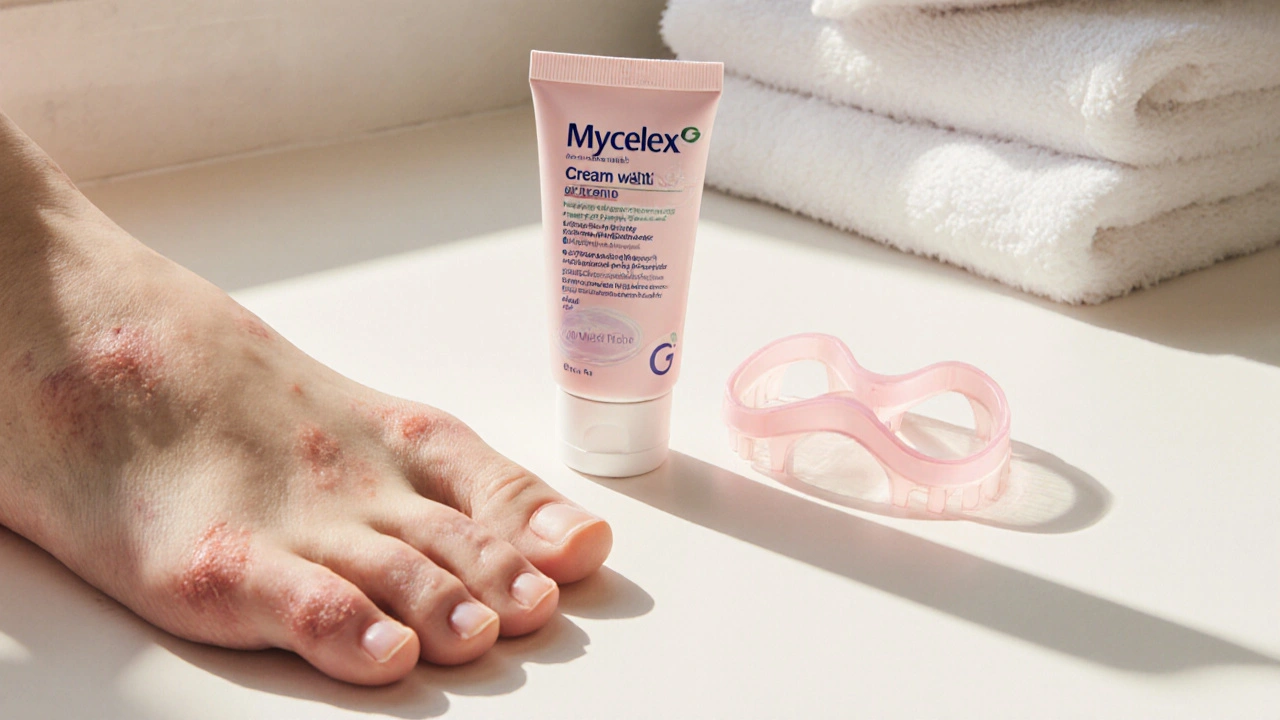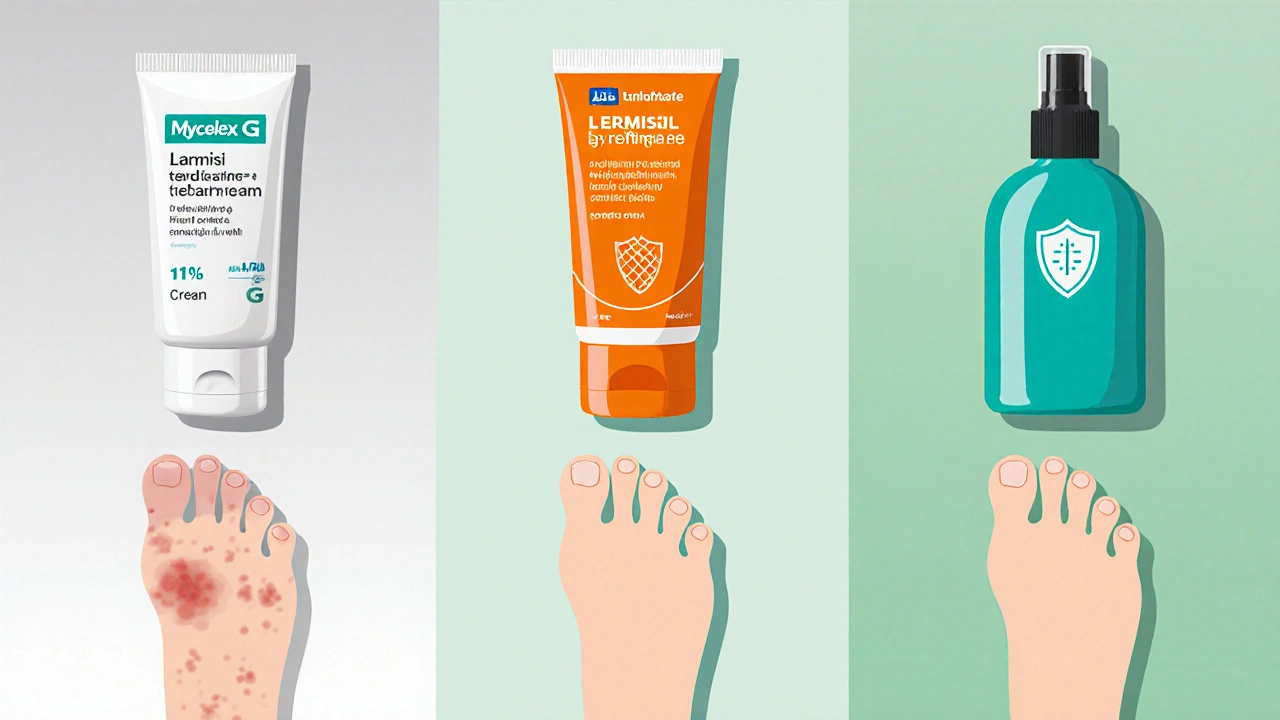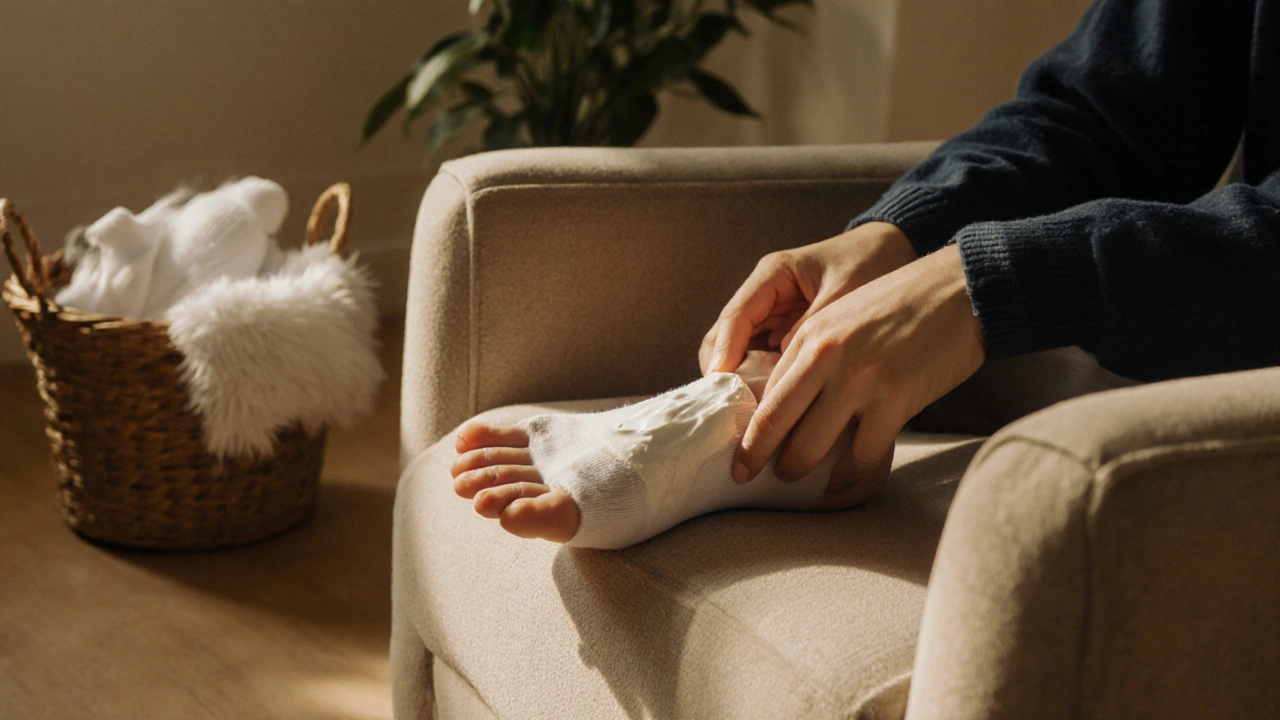Mycelex G (Clotrimazole) vs Top Antifungal Alternatives - Comparison Guide
 Oct, 12 2025
Oct, 12 2025
Thinking about treating a stubborn athlete’s foot, jock itch, or a yeast infection? You’ve probably seen the pink tube of Mycelex G at the pharmacy, but you might also wonder if there’s a better, cheaper, or faster‑acting option. This guide breaks down Mycelex G’s active ingredient, how it works, and how it stacks up against the most common over‑the‑counter and prescription antifungal alternatives.
Quick Takeaways
- Mycelex G contains clotrimazole 1% cream - excellent for mild‑to‑moderate skin fungal infections.
- Terbinafine (e.g., Lamisil) often clears infections in half the time but can be pricier.
- Miconazole and ketoconazole are good second‑line choices when clotrimazole isn’t effective.
- Tolnaftate works best for preventing recurrence rather than treating active infection.
- Naftifine offers a broad spectrum but is a prescription‑only product in many regions.
What is Mycelex G?
Mycelex G is a topical cream that contains 1% clotrimazole, an imidazole‑type antifungal medication designed to treat superficial fungal infections of the skin and nails. The brand is marketed primarily in the UK and Ireland and is available without a prescription for conditions like athlete’s foot, ringworm, and yeast infections of the skin.
How does clotrimazole work?
Clotrimazole is an antifungal agent that inhibits the synthesis of ergosterol, a critical component of fungal cell membranes. Without ergosterol, the fungal cell becomes leaky and eventually dies. This mechanism makes clotrimazole effective against a wide range of dermatophytes (e.g., Trichophyton, Microsporum) and yeasts such as Candida albicans.

Top Antifungal Alternatives
Below are the most frequently mentioned alternatives, each with its own strengths and typical use cases.
Terbinafine
Terbinafine is an allylamine antifungal that disrupts fungal cell membrane synthesis by inhibiting squalene epoxidase. It’s sold as a 1% cream (e.g., Lamisil) and as oral tablets for more severe infections. In clinical trials, terbinafine cleared athlete’s foot in an average of 3‑4 days, compared with 7‑10 days for clotrimazole.
Miconazole
Miconazole belongs to the imidazole family, similar to clotrimazole, but its broader spectrum includes some resistant strains of dermatophytes. It’s available as a 2% cream or spray (e.g., Daktarin). Users often notice faster relief of itching, though the overall cure rate is comparable to clotrimazole.
Ketoconazole
Ketoconazole is another imidazole that penetrates the skin well and is especially useful for seborrheic dermatitis and dandruff‑related fungal overgrowth. Over‑the‑counter 2% creams (e.g., Nizoral) are common, but higher‑strength formulations require a prescription.
Tolnaftate
Tolnaftate works by inhibiting fungal growth without directly targeting ergosterol synthesis. It’s sold as a 1% spray or powder (e.g., Tinactin) and is praised for its ease of use in preventing recurrent infections, though it’s less potent for active, thick‑scale cases.
Naftifine
Naftifine is a benzylamine antifungal that offers both antifungal and anti‑inflammatory effects. Prescription‑only in many countries, it’s typically a 1% cream (e.g., Naftin). Patients report rapid symptom relief, often within 48 hours, but the cost can be double that of clotrimazole.
Side‑by‑Side Comparison
| Product | Active Ingredient | Formulation | Typical Treatment Duration* | OTC / Prescription | Average Cost (UK) |
|---|---|---|---|---|---|
| Mycelex G | Clotrimazole 1% | Cream tube (15g) | 7‑10days | OTC | £3.50 |
| Terbinafine (Lamisil) | Terbinafine 1% | Cream tube (15g) / tablets 250mg | 3‑5days (cream) / 2‑4weeks (oral) | OTC (cream), Prescription (oral) | £5.80 (cream) |
| Miconazole (Daktarin) | Miconazole 2% | Cream or spray (15g) | 5‑7days | OTC | £4.20 |
| Ketoconazole (Nizoral) | Ketoconazole 2% | Cream (15g) | 7‑10days | OTC (2%); Prescription for higher strengths | £4.50 |
| Tolnaftate (Tinactin) | Tolnaftate 1% | Spray, powder or cream (15g) | 7‑14days (active infection) - excellent for prophylaxis | OTC | £3.00 |
| Naftifine (Naftin) | Naftifine 1% | Cream (15g) | 3‑5days | Prescription | £9.00 |
*Treatment duration assumes mild‑to‑moderate infection, twice‑daily application, and adherence to instructions.
When to Choose Mycelex G
If you need a cost‑effective, readily available solution for a small‑to‑medium spot of athlete’s foot or a mild yeast rash, Mycelex G is a solid pick. Its 1% clotrimazole concentration is sufficient for most dermatophyte infections, and the cream base spreads easily without a greasy feel.
However, consider the following scenarios where an alternative may be smarter:
- Fast relief needed: Terbinafine or Naftifine typically shrink lesions faster.
- Thickened nail involvement: Oral terbinafine tablets are the gold standard; topical clotrimazole struggles to penetrate nail plates.
- Recurrent infections: Tolnaftate’s preventive spray works well as a weekly maintenance regimen.
- Prescription required for severe cases: Ketoconazole 2% cream or oral formulations can tackle resistant strains.

How to Use Antifungal Topicals Correctly
- Wash the affected area with mild soap and warm water.
- Pat dry thoroughly - moisture fuels fungi.
- Apply a thin layer of the cream or spray to the lesion and a 2‑cm margin of healthy skin.
- Rub gently until absorbed; avoid occlusive dressings unless advised by a doctor.
- Repeat twice daily (morning and night) for the full course, even if symptoms disappear.
- For foot infections, wear breathable cotton socks and change them daily.
Skipping doses or stopping early is the most common reason for relapse, regardless of which product you choose.
Potential Side Effects & Safety
All topical antifungals share a low‑risk profile, but be aware of these possibilities:
- Transient burning or stinging - usually fades within 1‑2days.
- Localized redness or rash - could indicate allergic sensitivity; discontinue and seek medical advice.
- Rare systemic absorption leading to liver enzyme changes - mainly a concern with extensive, prolonged use of high‑potency agents like ketoconazole.
Pregnant or breastfeeding individuals should consult a healthcare professional before using any antifungal, especially prescription‑only options.
Frequently Asked Questions
Can I use Mycelex G on fungal nail infections?
Clotrimazole cream can help early‑stage nail involvement, but it doesn’t penetrate thick nail plates well. For established onychomycosis, oral terbinafine or prescription‑strength topical solutions are usually recommended.
Is it safe to combine two antifungal creams?
Mixing products isn’t necessary and can increase irritation risk. Choose one agent, apply it consistently, and if there’s no improvement after the recommended course, see a clinician for a possible switch.
How long should I wait before seeing results?
Most users notice reduced itching and redness within 2‑3days. Full clearance of the rash typically takes the full treatment length (7‑10days for clotrimazole, 3‑5days for terbinafine).
Can I use Mycelex G on children?
Yes, the cream is approved for children over 2years old. Apply a thin layer and monitor for any skin irritation.
What should I do if the infection worsens after a few days?
Stop using the product, clean the area, and consult a healthcare professional. Worsening could signal a resistant fungus or a secondary bacterial infection that needs different treatment.
Bottom line: Mycelex G is a reliable, budget‑friendly option for most mild skin fungal infections. If you need quicker relief, are dealing with thick nail disease, or have recurrent outbreaks, exploring terbinafine, naftifine, or even a preventive regimen with tolnaftate could be worth the extra cost. Always follow the application guide, complete the full course, and seek medical advice for stubborn or worsening cases.
Matt Cress
October 12, 2025 AT 18:41Oh great, another miracle cream that costs less than a coffee.
sweta siddu
October 13, 2025 AT 12:45Hey Matt! 😄 I actually love Mycelex G for mild stuff – it’s cheap, easy to find, and does the job. The comparison guide you shared is super helpful, especially the part about how quickly terbinafine works.
Andy Williams
October 14, 2025 AT 06:48Clotrimazole’s mechanism of inhibiting ergosterol synthesis is well‑documented, and its 1 % concentration in Mycelex G is adequate for most dermatophyte infections. However, for extensive tinea pedis, terbinafine’s faster mycologic cure rates make it the preferred option.
Paige Crippen
October 15, 2025 AT 00:51Don’t be fooled by the “well‑documented” label; big pharma pushes clotrimazole to keep us buying cheap OTC stuff while hiding more effective treatments. They’ll never tell you that the newer azoles are being suppressed.
Ted Mann
October 15, 2025 AT 18:55When we stare at a tiny cream tube, we are really confronting the paradox of modern medicine: a simple formulation that masks a complex battle between host and fungus. The skin, our largest organ, becomes a battlefield where ergosterol synthesis is the artillery line for the invader. Clotrimazole, by sabotaging that line, forces the fungus into a state of existential dread. Yet the human mind, ever prone to shortcuts, prefers the familiar pink tube over the unfamiliar but potentially superior alternatives. This preference is not merely about cost; it is about the comfort of the known, a psychological safety net. The guide rightly points out that terbinafine can clear an infection in half the time, but many users cling to Mycelex G because it has been on the shelves for decades. Such inertia is a microcosm of how societies resist change, even when evidence supports it. On the other hand, the broader spectrum of miconazole and ketoconazole offers a hedge against resistant strains, an important consideration for immunocompromised individuals. Tolnaftate’s role as a prophylactic agent reminds us that prevention often outweighs cure in long‑term health strategies. The cost factor cannot be ignored; a £3.50 tube is a modest expense compared to a prescription‑only Naftifine regimen that doubles the price. Yet price alone should not dictate therapeutic choices when a patient’s quality of life is at stake. The guide’s step‑by‑step application advice also serves as a reminder that adherence, rather than the active ingredient alone, determines success. Moisture control, proper drying, and consistent twice‑daily dosing are the unsung heroes of fungal eradication. In the grand scheme, the choice of antifungal is a negotiation between efficacy, speed, cost, and personal circumstance. Ultimately, the “best” product is the one the patient will actually use correctly, because even the most potent drug is useless if abandoned prematurely. So, while Mycelex G remains a reliable workhorse, it is wise to keep the broader arsenal in mind for individualized care.
Linda Lavender
October 16, 2025 AT 12:58Oh, Ted, you’ve turned a humble cream discussion into an epic saga worthy of a Shakespearean tragedy! The way you weave pharmacology with philosophy is nothing short of theatrical brilliance. I can almost hear a choir chanting the virtues of ergosterol while the curtain rises on the “Battle of the Antifungals.” Yet, amidst this grandiloquent performance, let us not forget the humble foot that suffers in silence, yearning for relief. Your emphasis on adherence is, indeed, the silent hero of this drama, the unseen protagonist that saves the day. But what of the poor souls who cannot afford Naftifine’s lavish price tag? Their plight is a somber subplot that deserves a louder chorus. In the end, the curtain falls not on the most expensive drug, but on the one that is applied with unwavering devotion. Bravo, dear therapist of the skin, for reminding us that the greatest cure is often the simplest act of consistency.
Tom Bon
October 17, 2025 AT 07:01The comparative table in the guide provides a concise overview of each agent’s pharmacokinetics, typical treatment duration, and cost. Such structured data aids clinicians in making evidence‑based decisions for patients with varying severities of fungal infection.
Jay Ram
October 18, 2025 AT 01:05Exactly, Tom! It’s great to see the data laid out so clearly-makes picking the right product feel less overwhelming. Keep those helpful guides coming!
Clara Walker
October 18, 2025 AT 19:08We should be wary of relying on foreign‑made antifungals that push our healthcare costs higher; American‑manufactured options are often safer and more effective. The push for imported clotrimazole seems like a subtle way to weaken our domestic pharma industry.
Jana Winter
October 19, 2025 AT 13:11While your concern for domestic production is understandable, the statement contains several inaccuracies: clotrimazole is produced by multiple reputable manufacturers worldwide, and “safer” is a subjective claim that requires clinical evidence. It would be prudent to reference peer‑reviewed studies when making such assertions.
Elizabeth Nicole
October 20, 2025 AT 07:15I love how the guide breaks down each alternative and even gives real‑world tips like wearing breathable socks. For anyone hesitant to try a new product, those simple lifestyle tweaks can make a huge difference in outcomes.
Shaquel Jackson
October 21, 2025 AT 01:18Yep, those sock tips are handy 😊 but honestly, if you don’t stick to the twice‑daily schedule, even the best tips won’t save you.